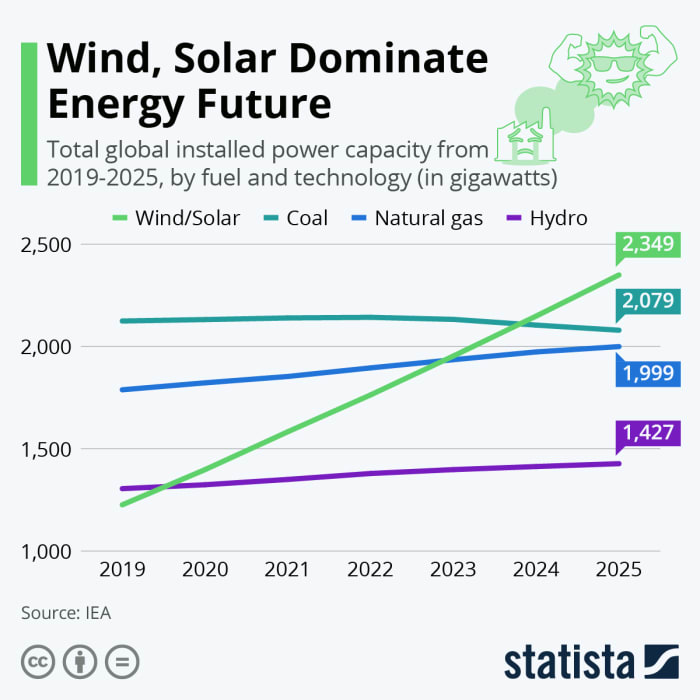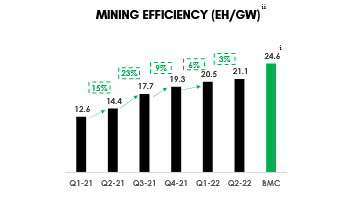This is an opinion editorial by Jerry Usman, an electrical engineer and tech writer.
Is progress being made toward green bitcoin mining? Absolutely! Despite the regulatory upheavals, reasonable progress has been made. Is Bitcoin green now? No, but at least Bitcoin’s greenhouse gas emissions are not where they used to be. According to the Cambridge Bitcoin Electricity Consumption Index, Bitcoin’s greenhouse gas emissions dropped from 59 metric tons of carbon dioxide equivalent in October 2021 to 48.88 metric tons today.
However, parliamentarians now have their gaze fixed on the proof-of-work consensus mechanism and are pushing for bitcoin mining to go green.
It’s a known fact that Bitcoin’s growing energy consumption has drawn criticism from environmentalists. Bitcoin miners must overcome the primordial sentiments that are often flung at emerging technologies that society seems initially uncomfortable with; consider Western Union’s internal memo from 1876: “This ‘telephone’ has too many shortcomings to be seriously considered as a means of communication. The device is inherently of no value to us.” The sentiments have remained the same. One should not be surprised when bitcoin becomes a standard for future currencies.
Some may have expected that the Paris Climate Agreement in 2015 would spur Bitcoin toward the more sustainable path of renewable energy. However, one shouldn’t be surprised by the apathy of Bitcoin’s accusers concerning the positive gains recorded with its limiting of carbon dioxide emissions.
Is solar mining the answer to the Bitcoin energy problem? Partially. Optimizing available energy and expanding working options requires a multidimensional approach. Various strategies include load balancing, energy swaps, hybrid systems and additional battery storage. The multiplier effect of increased government subsidies — an incentivized effort to speed up green energy adoption — could further cut solar installation costs.
A general overview of these energy solutions and their adoption is provided below.
Bitcoin’s Global Power Consumption
Bitcoin’s global power consumption stands at 253 TWh, approximately 0.15% of total global energy consumption. The Bitcoin network has achieved a more green power mix than Germany.
Source: Bitcoin Mining Council
According to the Bitcoin Mining Council’s 2022 report, 59.5% of the total bitcoin mining global energy comes from renewable sources, which is a good sign of progress. The council further reported a 46% increase in efficiency on a year-on-year basis due to increased mining efficiency and improved semiconductor technology.
Let’s get a rough sense of the current cost of bitcoin mining.
What Is The Average Profitability Of Bitcoin Mining?
Taking the powerful and popular bitcoin miner Antminer S19 Pro, rated at 3250 watts, it will consume 78kWh daily. This will cost $7.80 per day, at the rate of $0.10 per kWh, this yields a loss of $0.11. This is not a good scenario.
Cooling cost and a 50% discharge limit for lithium-ion batteries could further ramp up the price to mine bitcoin due to usable capacity. However, profitability is primarily impacted by electricity cost and mining difficulty. With cheap electricity, mining remains profitable regardless of bitcoin price.
Solar mining and other viable hybrids provide excellent alternatives. Though an element of geography and capital seems to be an advantage to mining success.
Different options exist to fast-track the green energy revolution with numerous benefits for bitcoin mining. The potential is incredible when we look at other green energy sources, but let’s get a glimpse of solar first.
Solar Energy And Mining Growth
Solar is now termed “the cheapest energy source.” The levelized cost of energy places onshore wind and solar ahead of other energy sources.
As the energy source with the fastest growth rate, solar power today supplies around 3% of the world’s electricity, producing zero noise pollution while possessing high scalability. Unlike relatively scarce geothermal, solar has worldwide potential.
The deployment of solar in conjunction with bitcoin mining continues to gain traction among entrepreneurs. Aspen Creek Digital Corp., a new bitcoin mining firm, has begun mining at a 6 megawatt (MW) solar-powered plant in western Colorado amid the current bear market.
However, wind and solar are significantly utilized in Texas, a booming place for bitcoin mining.
According to Shaun Connell, Executive VP of Power at Houston-based tech company Lancium, “You get this perfect overlap with both sun quality and wind speed in West Texas.”
Texas will continue to play a vital role in the green energy market. However, China remains a global leader in solar manufacturing and total installed capacity, contributing 15.4% of non-fossil fuels to its energy mix with a target of 33% by 2025.
Photovoltaic panels and solar radiation-concentrating mirrors are increasingly being used to harness solar energy as technology continues to advance.
Biomass Deployment In Bitcoin Mining
Biomass accounts for approximately 10% of the world’s energy, 5% of U.S. primary consumption and 1.4% of the electricity generated in Canada. The bulk of this energy is used for heating and other industrial processes, which has significant environmental advantages that extend to improving hygiene by recycling waste materials and reducing greenhouse gas emissions.
In the race to a sustainable bitcoin mining industry, using biodegradable materials as fuel for electricity production is not out of place. It may not provide a more significant arbitrage when paired against solar, but investing in these energy alternatives from an advantage remains the best.
Generation Hemp just partnered with Cryptic Solutions in an attempt to utilize hemp as biofuel to run its mining hardware. As reported in an article, Generation Hemp Chairman and CEO Gary Evans said:
“We decided that the ideal place to initiate our first green bitcoin mining operation was right in our own backyard. We are located in an industrial park of western Kentucky with ample low-cost electric availability and a very friendly business environment.”
Using biodegradable waste from farms to generate electricity to mine bitcoin is an interesting way to economically deploy otherwise wasted materials that could be a source of land and water contamination, but instead creates carbon dioxide emissions when these resources are now used for mining bitcoin. It is likely that using these types of biowaste materials for bitcoin mining will be more impactful for society by preventing health issues that arise with contamination than the carbon dioxide emissions they create. That being said, scalability of these solutions remains a significant concern.
Can Bitcoin Be Mined With Wind Energy?
With a 25-year service life for wind turbines, it is more rewarding for bitcoin mining than solar power when maintenance is considered.
Wind speed, air density and swept area serve as reminders that location is crucial when it comes to wind energy. Constrained by the Betz Limit, engineers have been exploring design options that provide the best optimization of wind turbine efficiency while reducing cost. Horizontal axis turbines are standard. However, bladeless turbine concepts are gaining ground, though they can’t be seen as significant competitors.
Wind power designs are experiencing accelerated improvement in design efficiency and capacity. Implementing more wind-powered mining systems will improve the renewable energy mix of bitcoin mining. However, wind power suffers the same fate as solar and will require batteries for shortfalls during less windy periods. Also, it’s best scaled by adding energy to the grid in a distributed model.
Source: Statistica
Wind energy is efficient, inexhaustible and affordable. Wind energy is the largest renewable power source in the United States and growing. However, if not carefully planned, wind installations create noise and pose environmental concerns.
Hydropower And Bitcoin Mining?
Hydropower has the highest energy extraction (conversion) efficiency of up to 90%, the highest among renewable energy options, the most reliable and it maintains the lowest carbon footprint.
Alps Blockchain, an Italian startup, is one firm that has deployed the use of hydropower for bitcoin mining in Borgo d’Anaunia. With an energy firm struggling to cover its facility maintenance costs, it was easy for Alps Blockchain to purchase more than 40 state-of-the-art ASIC miners at a cheaper rate and resell the computing power worldwide.
Hydropower is stable and affordable. It remains one of the earliest and most adopted energy sources. It accounts for over 18% of global power generation and is the most stable mining option requiring no backups. It’s worth noting that great apathy exists among engineers and scientists when referring to hydropower as renewable, considering its environmental impact.
Load Balancing Of Renewable Options
Incentivized load curtailment at peak demand periods will continue in an attempt to flatten losses. Miners’ involvement remains relevant, but wholesale prices have fallen due to the solar value deflation caused by the time-locked supply of solar energy, resulting in utilities paying less for solar.
The growing market for electric cars and the Bitcoin network offer profitable alternatives to the industry’s solar value decline. Solar bitcoin mining could reduce solar value deflation to a great extent while reducing the need for generated energy curtailment, at the same time freeing up power during peak demand, especially when grid-dependent backups are incorporated.
Long Distance Energy Swap
Superconducting commercial direct current (DC) power transmission will reduce significant losses in realizing underwater long-distance power transmission (intercontinental level inclusive). High-voltage DC use has recorded both success and failure in this ambitious attempt. A recent popular project is the Australian-Singapore (ASEAN) solar power line.
Time-limited solar and other seasonal energy resources with tremendous abundance could be swapped between regions with similar characteristics having opposite availability periods.
It’s important to note that long-distance energy swaps pose a significant security risk when used as a primary power source if maintenance and emergencies are taken into account. These same systems have tremendous advantages when used as backup power.
One illustration is Denmark and Norway’s pumped water storage, which provides energy for Denmark when there is no wind. It’s interesting how Norway’s mountainous water resources complement Denmark’s high seasonal winds.
Increased Storage To Optimize Solar Mining
Technological improvements have helped offset solar value depreciation, especially in batteries.
The decentralized nature of Bitcoin makes it an advantage to have intermittent power supplies added to the network, which makes it profitable for the energy grid and investors at the same time while also maintaining a decentralized ecosystem.
Battery scaling has become the go-to choice for miners seeking to reap the full benefits of their investments. Blockstream and payment firm Block have partnered with Tesla to construct an entirely off-grid, bitcoin mining facility using renewable energy. This includes deploying 3.8 MW of solar panels with four Tesla Megapack battery units.
Continuous Increase In Bitcoin Mining Efficiency
Bitcoin’s carbon footprint is dropping drastically as mining efficiency continues to improve on a recorded 63% year-over-year basis. According to the Bitcoin Mining Council, a six-fold improvement is expected with the Bitcoin protocol and efficiency in mining within the next eight years.
Source: https://bitcoinminingcouncil.com
Final Thoughts
A hybrid renewable energy system has proven greater efficiency in electricity production, which can only mean more profitability for mining. With perfect geography, the solar-wind hybrid system is sustainable.
The combined impact of technological advancement, government subsidies and hybrid renewable systems can trigger the transition to green energy at a breakneck speed. Utilizing energy balancing techniques, curtailment and increased storage will put the lid on mitigating the inefficiency in expending available power, support efforts to combat climate change and pave the way for greater profitability in bitcoin mining.
This is a guest post by Jerry Usman. Opinions expressed are entirely their own and do not necessarily reflect those of BTC Inc. or Bitcoin Magazine.
Source: https://bitcoinmagazine.com/culture/renewables-will-optimize-bitcoin-mining




